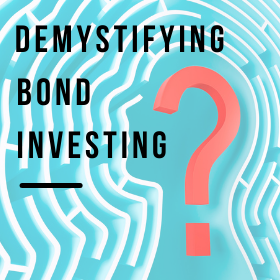By Dan Abdill, Senior Investment Officer (retired)
Easier than you think
As bond yields continue to rise more rapidly than rates on certificates of deposit (CDs), and fewer CDs are being issued, Catalyst Corporate’s Brokerage Team is fielding more credit union inquiries about investing in bonds. Is your credit union considering investing in bonds for the first time? If so, where do you start?
 Bond investing doesn’t have to be complicated
Bond investing doesn’t have to be complicated
Like many specialized fields within the financial services industry, bond investing is rich with jargon, which sometimes creates an illusion of complexity. For that reason, starting with core terminology often helps demystify bond investment concepts.
Bond-speak 101
Starting at the top of the alphabet, A is for…agencies (and acronyms). “Agencies” is a general, frequently used term that refers to the entities that issue bonds and the bonds themselves. When you hear “agencies,” think
of the following:
- Federal National Mortgage Association, known as Fannie Mae
- Federal Home Loan Mortgage Corporation, or Freddie Mac
- Federal Home Loan Banks, often abbreviated FHLB
- Federal Farm Credit Bank (FFCB)
- Federal Agricultural Mortgage Corporation, aka Farmer Mac
Such agencies, along with the U.S. Treasury, are the primary issuers of bonds for credit union buyers. The various types of debt issued by the U.S. Treasury are collectively referred to as “treasuries.” Their variety of maturities can make them a good complement to an existing CD ladder.
Making a loan to an agency
Bonds are a “debt obligation” of the issuer, which essentially means the borrower sets the loan terms. Two types of bonds commonly issued by agencies include: 1) bullets, and 2) callables. Similar to CDs, bullets are bonds with a fixed rate of return and a fixed maturity date.
Callables, on the other hand, are bonds that allow the issuer to return the investors’ principal at predetermined points in time prior to maturity. In keeping with the loan analogy, this means the issuer can pay off (i.e., “call”) the debt early without penalty. This usually happens when rates fall, and new bonds can be issued at lower rates (similar to refinancing). However, callables have higher yields than bullets to help compensate for the issuer having this call option.
“Call schedules” are set when a bond is issued. The most common call schedules are quarterly, one time and continuous. The period before the first call date is known as the “lock-out,” which typically consists of a period of three months, six months or one year. Continuously callable bonds can be called with a five-day notice any time after the lock-out.
‘I’ll buy that’
Bond prices are categorized into three types: 1) par, 2) discount, and 3) premium. All are issued with a stated rate of return, or “coupon.” The price of a specific bond is determined by its term and coupon, relative to rates in the larger bond market.
For example, if a bond is issued with a 1.00 percent coupon for five years and similar five-year bonds also have 1.00 percent coupons, the bond’s price would be set at “par.”1 A par price means you pay a dollar for every dollar of bond principal you buy. Purchase $250,000 of a bond priced at $100 (par) and you pay $250,000.
If market events suddenly cause slightly newer five-year bonds to have a 1.05 percent coupon, the price of the 1.00 percent bond will be discounted, so its effective yield equals 1.05 percent. Buy $250,000 of a five-year 1.00 percent bond priced at 99.76 and you pay $249,392. However, you bought $250,000 of principal and $250,000 is returned to you at maturity. The difference between what you paid and what is returned creates an effective yield of 1.05 percent.
Conversely, if coupons for the same (slightly newer) five-year bonds shift to 0.95 percent, the 1.00 percent bond will be priced at a premium, so its effective yield equals 0.95 percent. Buy $250,000 of principal at the premium price of $100.24 and you pay $250,609, but still receive $250,000 of principal at maturity. The premium paid reduces the yield.
A bond’s interest, or “coupon payments,” remains the same regardless of price. A 1.00 percent coupon bond pays $1,250 of interest every six months on $250,000 of principal. Agency bonds most often pay interest semiannually.
Although we’ve barely scratched the surface, I hope you can see that bond investing doesn’t have to be complicated – especially when you have the trusted insight and guidance of a Catalyst Corporate Investment Officer at your side. To learn more about bond investing, contact the Brokerage Team today. We stand ready to help you with everything from policy suggestions and educating your board members to opening a brokerage account with CU Investment Solutions, LLC.
1 Please note: Pricing examples are hypothetical, do not represent specific bonds, and do not constitute an offer to buy or sell specific bonds.
All securities are offered through CU Investment Solutions, LLC. The home office is located at 8500 W 110th St, Suite 650, Overland Park, KS 66210. CU Investment Solutions, LLC registered with the Securities and Exchange Commission (SEC) as a broker-dealer under the Securities Exchange Act of 1934. CU Investment Solutions, LLC is registered in the state of Kansas as an investment advisor. Member of FINRA and SIPC. All investments carry risk; please speak with your representative to gain a full understanding of said risks. Securities offered are not insured by the FDIC or NCUSIF and may lose value. All opinions, prices and yields are subject to change without notice.